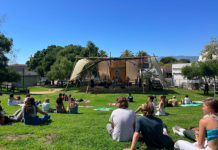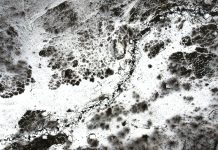Zoe Manzanetti
Last Wednesday’s Interdisciplinary Humanities Center lecture was an interesting introduction to a realm of the military that is not commonly discussed: the injured. Dr. Jasbir K. Puar, a women’s and gender studies professor at Rutgers University, discussed the use of biopolitics in the Israeli-Palestinian Conflict. Puar’s presentation focused more specifically on Israel’s use of biopolitics and gendering as a weapon against Palestine, captivating the audience as we learned about the intricacies involved in the tragic and nuanced conflict.
One theme is the idea that “like meets like and attempts to override” in the sense that both Israel and Palestine are contending for the same space and it is this contention, this conflict, that has resulted in millions of deaths for hundreds of years. These attacks are easily recorded through the number of deaths, because casualties are relatively easy to record.
However, these states have come to understand this method of documentation and have, just like their attack methods, evolved over time. Puar said that in one event there were a total of 2,200 deaths, but the number of injured was estimated at more than 15,000. The true difficulty is in determining what constitutes injured versus debilitated versus collateral damage; if a group can minimize their number of deaths, their ferocity seems to minimize as well.
Puar claimed that the founding of the Israeli state was started as a deracialization project; it was a rehabilitation of the Holocaust and diasporic dispersion, that was trying to cleanse the Middle Eastern state and make it “pure” once again. She argued this conflict is much of the same. Rehabilitation narratives are constitutive of most nation-state projects, but in the current situation it is only intensified. This case aims to rehabilitate masculinity and heterosexuality, amongst other traits, and Israel vies for this rehabilitation through the settler colonialism of people.
The settler colonialism through people, as stated by the lecture, was achieved through militarization of biopolitics. The first way in which Israel aimed to achieve this was through maiming. While Americans may often hear the term “shoot to kill,” Israeli occupation forces are taught to “shoot to cripple” and “shoot to maim” to ensure that the person doesn’t die, but that they are no longer a threat. Tactics include illegal use of guns and weaponry, flaming of homes, schools, mosques, use of white phosphorus and the bombings of hospitals and medical areas. Attacks on hospitals are direct violations of medical neutrality accords that have existed since World War II, stating that all medical areas are safe zones. The lecture claimed that Israel was no longer following any rules.
Maiming has become the primary vector of biopolitical control as it escapes the regulations of legality, biopolitics and necropolitics; it is a manipulated and militarized version of epigenetics. The lecture claimed that this elusive tactic is often misperceived as preservation of life, but this does not seem to be the case — it is simply an evasion of rules. This is because a death that results as a consequence of battle, but is delayed years after the event, doesn’t count in the death toll for that battle. The new end goal has become to keep people alive and active in society, but permanently disable them so they can no longer be a threat. Maiming has increased on a massive scale and is no longer just a byproduct of the conflict.
In addition to maiming, “stunting” is also a newly developed tactic that is now being implemented, said Puar. She discussed how Israel will target reproductive organs in attempts to stunt Palestinian culture, to stop self-sustaining Palestinian life in the future. Stunting is truncation of reproductive capacities or dismemberment of reproduction organs as a form of preemptive gendering. Both maiming and stunting involve forcing a bodily change to achieve a desired standard.
One of the main problems and driving forces of this mentality, according to Puar, is the over-representation of a certain kind of person — the white male. The reality is, this is just one genre of humankind, as well as an inaccurate portrayal of much of the world, and, unfortunately, gender is a function of genre.
The lecture concluded with the idea that all of this was derived in attempts to produce a specific, supposedly better, phenotype as the only phenotype present. All of this new militarization of epigenetics is simply a new weapon; dehabilitation projects as a form of queer weaponry. While in the United States, people are free to combat regulations and government, this freedom is very rare elsewhere, especially in the geographical region that the lecture focused on. We have the power to fight these problems here, but Queer Studies is a Euro-American focused study and other parts of the world aren’t so fortunate.













Comments are closed.